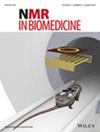The added value of diffusion tensor imaging with systematic bias correction for the assessment of liver morphology and physiology
IF 2.7
4区 医学
Q2 BIOPHYSICS
引用次数: 0
Abstract
Diffusion‐weighted images of the human liver are prone to artifacts from bulk motions, poor SNR, non‐uniformity of magnetic field gradients, and non‐optimal choice of diffusion weightings. These factors markedly affect diffusion tensor imaging (DTI) metrics such as mean diffusivity (MD) and fractional anisotropy (FA).This work presents a simple preprocessing pipeline for enhanced magnetic field gradient non‐uniformity calibration and analysis of the systematic bias removal attained in each correction step.Liver DTI scans were conducted in two isotropic phantoms and one healthy volunteer. Diffusion tensor was calculated for the original data and after denoising, B1 correction, rigid body registration, and magnetic field gradient non‐uniformity correction applying the B‐matrix spatial distribution (BSD) method and then, compared with the standard approach (sDTI). MD and FA were determined in three segments of the right lobe from DTI using four different combinations of弥散张量成像在评估肝脏形态学和生理学方面的附加值
人体肝脏的扩散加权图像容易受到体积运动、信噪比差、磁场梯度不均匀以及扩散加权选择不理想等因素的影响。这些因素会明显影响弥散张量成像(DTI)指标,如平均弥散率(MD)和分数各向异性(FA)。本研究介绍了一种用于增强磁场梯度非均匀性校准的简单预处理流水线,并对每个校正步骤中实现的系统性偏差消除进行了分析。应用 B 矩阵空间分布(BSD)方法计算原始数据和去噪、B1 校正、刚体配准和磁场梯度不均匀性校正后的扩散张量,然后与标准方法(sDTI)进行比较。结果表明,建议的预处理和 BSD 方法对偏离中心和等中心各向同性模型中的 MD 和 FA 值有显著影响。对人体肝脏进行修正后,MD 值变化了 11%,FA 值变化了 - 64%。噪声、B1 不均匀性、错误配准和非均匀磁场梯度会显著改变各向同性模型和人体肝脏中的 DTI 指标分布。基本预处理和 B 矩阵空间分布 (BSD) 方法在偏离中心和等中心位置时表现不同。在人体肝脏中,它们分别消除了高达-63%和11%的FA和MD系统性偏差。b值集之间FA和MD的明显差异表明,DTI可能对不同的肝脏区块敏感。
本文章由计算机程序翻译,如有差异,请以英文原文为准。
求助全文
约1分钟内获得全文
求助全文
来源期刊

NMR in Biomedicine
医学-光谱学
CiteScore
6.00
自引率
10.30%
发文量
209
审稿时长
3-8 weeks
期刊介绍:
NMR in Biomedicine is a journal devoted to the publication of original full-length papers, rapid communications and review articles describing the development of magnetic resonance spectroscopy or imaging methods or their use to investigate physiological, biochemical, biophysical or medical problems. Topics for submitted papers should be in one of the following general categories: (a) development of methods and instrumentation for MR of biological systems; (b) studies of normal or diseased organs, tissues or cells; (c) diagnosis or treatment of disease. Reports may cover work on patients or healthy human subjects, in vivo animal experiments, studies of isolated organs or cultured cells, analysis of tissue extracts, NMR theory, experimental techniques, or instrumentation.
 求助内容:
求助内容: 应助结果提醒方式:
应助结果提醒方式:


